Intercultural training goes digital, a trainer’s perspective
Dec 13, 2017 · by Richard Farkas

A revolution for trainers
The change has happened. Intercultural training has gone online. And there is more change to come. Argonaut met Béatrice Rivas Siedel, an intercultural coach and trainer based in Paris and member of Terres Neuves Network to get a trainer’s perspective on the rush into e-learning.
“For years not much happened, except for a few early adopters running pilots and low-profile projects” says Béatrice. “Some big organisations had online self-study tools for intercultural skills, but trainers were able to continue training in traditional ways. That’s all past now. Today clients and employees expect to learn online – at least partly.
We are training in a period of complete transformation lasting just a few years
Béatrice is a leading part of the trend in her home market, France. She tracks the development through industry reports, including the IFTS survey. “The trend towards digital learning is happening at rate of around 7% per year. We are living in and training in a period of complete transformation lasting just a few years”.
“That feels like a step change, and we’re noticing it”, says Béatrice. “These trends have hit intercultural training too, and it’s a shock for those trainers not ready or able to adapt.”
What trainers can do
Béatrice believes that further change is inevitable. “The end result must be that trainers incorporate technology deeper into their work. Trainers will find their own unique path which suits them and their client base. I’ve told the story of My breakthrough moments as an intercultural trainer in a recent blog post here.”
Being part of the discussion
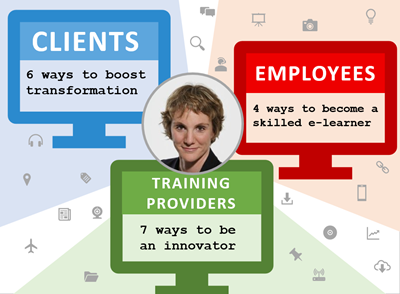
We asked how trainers can take a bigger role in the e-learning revolution. “Trainers also need to have a louder voice in this transformation. They have valuable expertise in how learning happens.” Béatrice lists the three groups who could benefit from hearing the insights and getting support from the trainers.
Opening the conversation about e-learning with
- training providers who engage trainers
- clients who have the organisational needs
- employees who participate in training
“They are all on the same journey into technology-enabled learning.”
New training methods in practice
While talking and listening are important, Béatrice says trainers also need to experiment with change. One area is to build solid expertise in facilitating virtual training sessions. Béatrice has shared eight actions for trainers switching to virtual training.
What employees can do
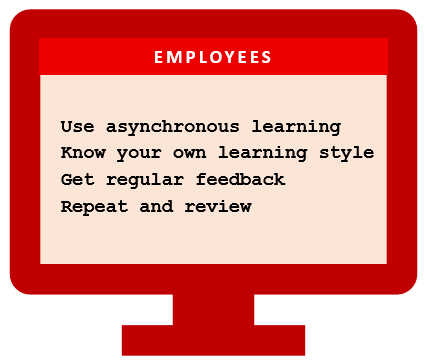
Completing a training programme which is 50%-100% remote can be a great experience as a learner. Here are some of the opportunities which Béatrice encourages her training participants to consider:
- Take advantage of asynchronous learning, which is learning which you can fully schedule, where you are not required to be in a live call or live session with the trainer or others. Make a schedule which suits you in terms of pace, time of day, length of session, your physical location.
- Get to know your own learning style, and make sure you benefit from that, especially if the trainer is remote or if you are working alone. For example, if you are visual and kinaesthetic (using movement and touch), then draw and write. This helps you learn better as you watch video or read content. Do no not allow yourself to take the role of passive recipient of knowledge and skills. Be an active e-learner.
- Get regular feedback: use the tests which are often built into the online learning platform, participate in games, ask the trainer and co-learners to give you feedback
- Repeat and review. Many people learn lasting skills and get lasting knowledge by repetition or returning to material with fresh eyes. Reviews and repetition are great for memory.
What training providers can do
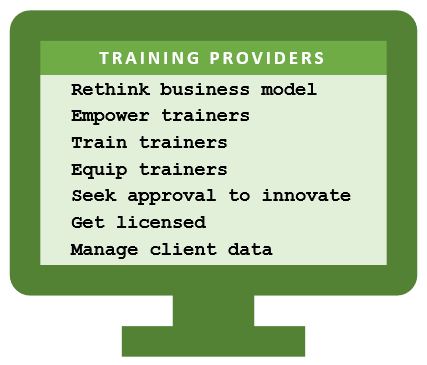
Béatrice proposes that training organisations re-think their business models, in dialogue with their customers and with their trainers. “Some trainers are not convinced. They worry that as e-learning rises, the quality of human interaction falls. There is scepticism and criticism. Here in France, we may express our opposition openly. Often trainers fear that F2F trainings will disappear.”
Some training providers have successfully involved trainers in piloting new models, based on blended learning approaches. “Training providers should empower trainers to design the training structure to fit customer needs.” Béatrice points to one model which already becoming a classic blended learning training structure:
one remote asynchronous module → then live F2F → then social media
But many different structures are possible. “We are moving out of the era when clients come to training providers for a rigid model or fixed approach to training design,” Béatrice continues. “Although training providers need to build their brand and the unique advantages of their approach, they should also reserve creative space for the trainer to construct the learning around the precise needs of the client in each case.”
Innovative intercultural training providers
Terres Neuves, part of the Ceran group, is one example of an innovator in this area which gets good feedback from Béatrice. “They are working with the Argonaut team to provide training for consultants, and support when clients and trainers adopt new techniques.”
“Training providers like Terres Neuves can give opportunities for trainers to acquire new skills necessary for success with e-learning. Key skills for trainers are:
- leading virtual meetings
- using technology in face-to-face training sessions (and know when not to)
- remote mentoring, use of chat rooms for longer-term processes with clients
- content creation, starting with blogs, video interviews and so on.”
Digital learning will not make face-to-face training disappear.
Béatrice notes that training providers have an important role in getting permission from the client to mix synchronous and asynchronous learning. She adds that training providers can make sure that trainers have access to technologies, even something as simple as social media, which is often a great module to complete a training or to enable continued involvement.
“One of the most significant decisions a training provider must make, is the decision to licence learning technology. They will need a good learning management system with good tracking, so the client can find out what’s happening.”
What clients can do
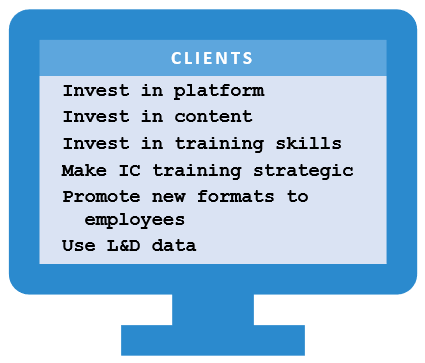
Most of Béatrice’s clients have a learning and development strategy which includes increasing the use of e-learning. They are already on track to boost the use of technology in their employees’ training. But intercultural training is rarely the first area to get investment or to see change.
“Clients can achieve benefits in intercultural training too”, says Béatrice. She highlights some advantages and obstacles that are relevant for intercultural training too.
- Seek flexible training designs, both to control the cost and to find a better individual fit for the employee or group
- Promote the possibilities to employees
- Demand, review and use tracking data about the training, to influence the design of future trainings
Reduce or remove these obstacles for training companies:
- Investment in platform: opening corporate Learning Management Systems for intercultural training, or accepting the platform costs in external intercultural training provider solutions
- Investment in content, including industry-specific and company specific case-studies, shared in e-learning format
- Investment in training skills of in-house and freelance trainers; this can also happen at no cost for example by including external consultants in internal e-learning training courses for trainers and L&D managers
100% face to face is never best
Béatrice has become a convinced advocate of blended learning. “100% face to face is never best, just like 100% e-learning can never be best” she says.
Allowing employees some asynchronous learning time will always beat a seminar or course which is scheduled according to people’s calendars. “In asynchronous learning, you can learn at your own pace and use the synchronous (live or face-to-face) sessions for inspiration, energy, creativity and emotional experience. The Mix is more efficient than 100% face to face.”
Béatrice comments that cross-cultural training providers dominate her industry, and they can be drivers in our industry’s tech revolution.
It will happen anyway
She sees no threat to innovative trainers or training providers. “Digital learning will not make face-to-face training disappear. I would say the reverse. When a trainer can use remote training techniques, it moves the face-to-face part to a higher level.”
For Béatrice, the surest way to preserve face-to-face training is to incorporate digital learning. “As trainers, we can remove the PPT, and make our sessions truly interactive and experiential.”
More on careers in the intercultural consulting business
-
 Look on any interculturalist’s Kindle (or Kobo or other e-reader or even bookshelf) and you are…
Look on any interculturalist’s Kindle (or Kobo or other e-reader or even bookshelf) and you are… -
 This is the story of Béatrice Rivas Siedel's professional transformation as an intercultural trainer. In two…
This is the story of Béatrice Rivas Siedel's professional transformation as an intercultural trainer. In two… -
 It is an amazing feeling when you are part of lively network that is truly global.…
It is an amazing feeling when you are part of lively network that is truly global.… -
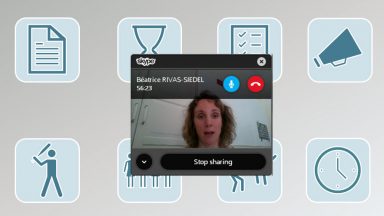 Intercultural coach and trainer Béatrice Rivas Siedel shares her tips for trainers who are shifting from…
Intercultural coach and trainer Béatrice Rivas Siedel shares her tips for trainers who are shifting from…
